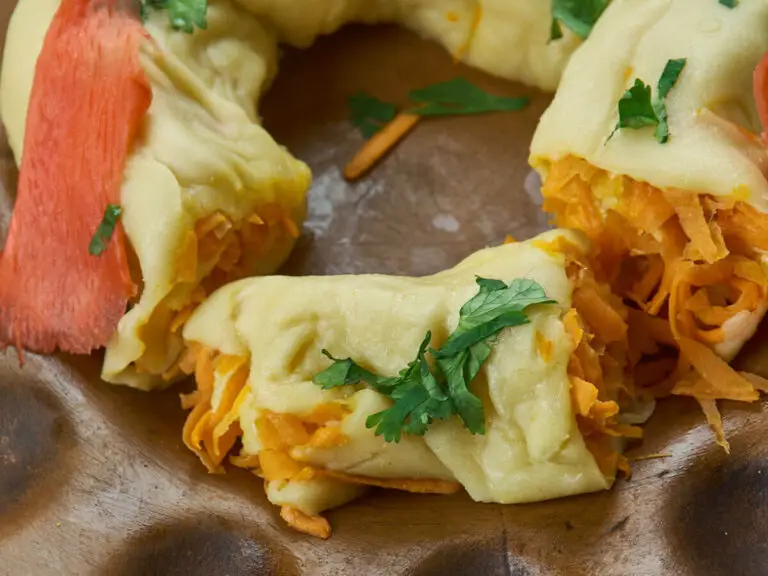Orama: Basic Information
Pronunciation
Alternative Name(s)
Dish Type
Course
Mealtime
Popular Variations
Orama: Ingredients and Preparation
Main Ingredients
Main Cooking Method
Preparation Process
Orama: A Deep Dive
Cultural Significance
Taste
Texture
Aroma
Color
Serving Style
Serving Temperature
Accompaniment
Occasions
Seasons
Special Diets
Calories
Popularity
Popular Similar Dishes
Popular Dining Area
Orama is a traditional pie that hails from Central Asia, especially beloved in Kazakh, Kyrgyz, Uzbek, Bashkir, and Mongolian cuisines. The name “orama” refers to the words that mean “to roll” or “to wrap”, which is precisely how it’s crafted.
To make orama, a simple dough of flour, water, and salt is prepared before being rolled out thinly for adding a filling with a variety of ingredients. Usually, common fillings include minced potatoes, meat, and animal fat.
Sometimes, minced pumpkin or other delightful veggies are added to the filling before the dough is gently rolled around the filling, forming long, slender wraps. These wraps are then neatly arranged in a circular pattern in steamer pots for cooking.
Beyond the ideas about orama, I’d like to guide you through some features that set orama apart from its dumpling family, the advantages and disadvantages, and other common concerns with the below insights.
Key Points
Orama Images
Pros and Cons of Eating Orama
Before diving into consuming any dish, it’s best to know about the advantages and disadvantages that orama offers.
Pros
Cons
I hope you find these pros and cons of orama interesting. With that said, you shouldn’t miss the chance to uncover more fascinating things when comparing orama with dumplings.
How Different Are Orama And Dumplings?
Orama and dumplings are different when it comes to origin, filling, shape, and cooking methods. For that, let me show you how these two are different from each other.

Orama
Origin: Central Asia
Filling: Meat, potatoes, and sometimes pumpkin
Shape: Rolled up into long shapes
Cooking Methods: Steaming

Dumplings
Origin: Worldwide
Filling: Various sweet or savory ingredients
Shape: Round or half-moon shapes
Cooking Methods: Boiling, frying, or steaming
So, while both orama and dumplings have dough and filling, they come from different places while possessing a look and taste quite different. After getting to know these differences, you should stick around to learn more about some inquiries relating to the dish.







Adam Sam
Senior Food and Drink Editor
Expertise
Food Writer & Recipe Developer, Recipe Tester, Bartender, Cooking-video Maker, Editor In Chief
Education
Adam Sam, an experienced food writer and recipe developer, is passionate about blending diverse culinary traditions, national dishes, and innovative beverages, showcasing his proficiency in both traditional and modern recipe testing.
As the Editor-in-Chief, he elevates culinary content from street food to fine dining, focusing on Western cuisine and types of drinks at azcuisines.com, and is professional in creating engaging cooking videos that simplify complex dishes and ingredients.
His passion for food is evident in his writing, where he uniquely merges various cultures, traditions, and contemporary trends, skillfully combining classic recipes with modern cooking methods.